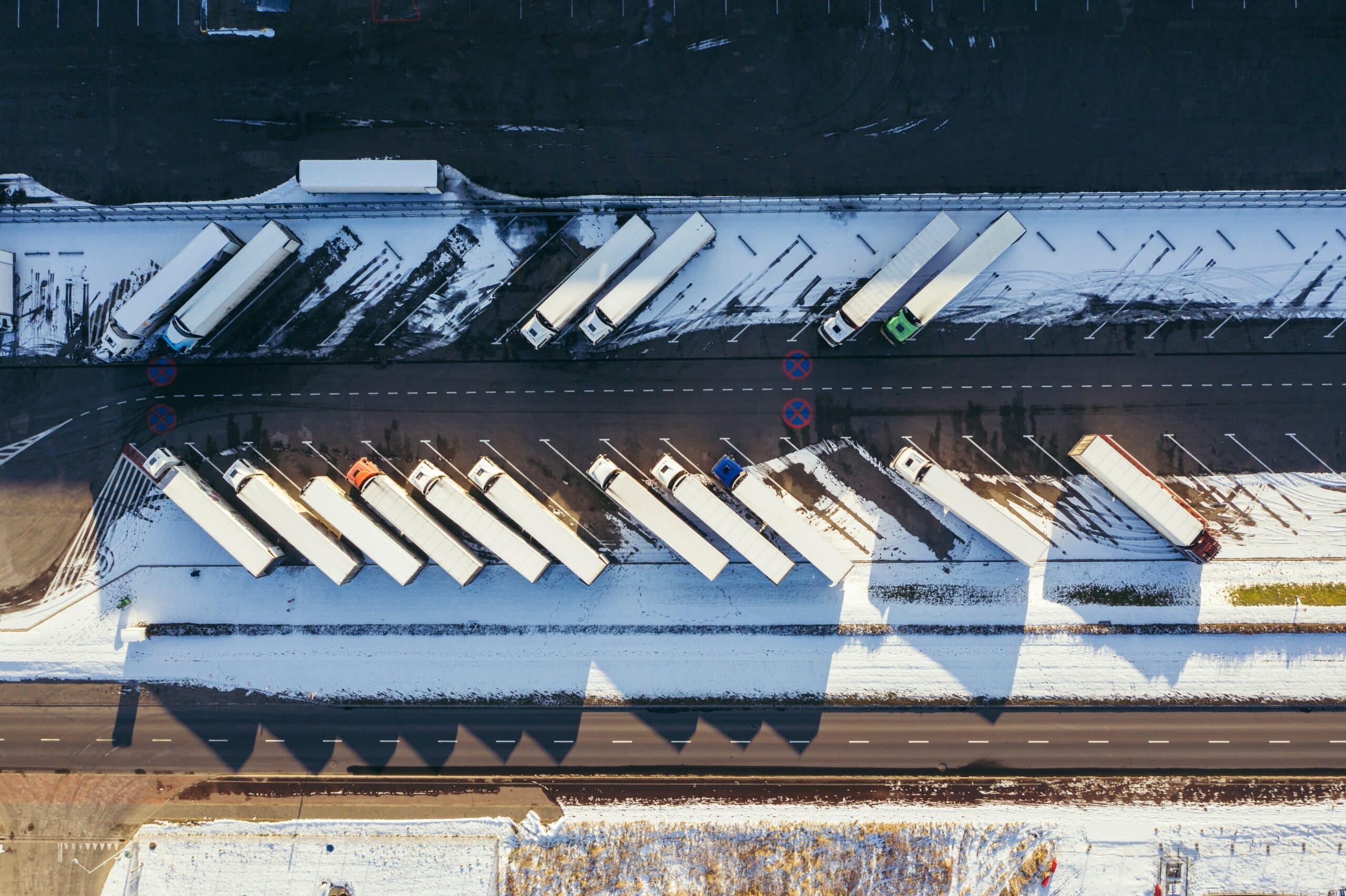The cold season is approaching and with it the change to winter tyres becomes obligatory. In many European countries, some new rules for trucks have been in force since 1 November. In Germany, since 2023 the regulation stipulates that commercial vehicles with a permissible total mass of over 3.5t must be equipped with winter tyres in winter conditions not only on the drive axle, but also on the front steering axles.
Germany goes even further for traffic safety: From October 2024 on, M+S tyres may no longer be used on drive and steering axles in winter conditions, but only those with the symbol of the three mountain peaks and the snowflake (Three-Peak-Mountain-Snowflake-Symbol, 3PMSF).
“Real” winter tyres compared to M+S tyres

However, the tyres with the mountain peaks and the snowflake – just like the M+S tyres – are not really winter tyres, but rather a compromise: they can be used all year round. If you are going for example to Norway in winter, you should rather buy real winter tyres. These provide a much better grip on snow and black ice, as this test also shows. Disadvantage: If you drive with these winter tyres in warmer areas (above 6°C), you would have to change the tyres again. This is because the softer “real” winter tyres then wear out much faster and make the vehicle run much more unsteadily. All-season tyres, on the other hand, have much less rolling resistance and more mileage.
Observe additional winter regulations
In addition to tyres, truck drivers must also follow other instructions. The website of the tyre manufacturer Continental provides a very good overview of all winter regulations for trucks and buses in the individual European countries. Here you will also find information on compulsory snow chains, the obligation to carry snow shovels or studded tyres.
What regulations apply in Europe?
With the help of Continental’s comprehensive overview, we show here how other countries handle the winter tyre obligation.
| Country | Tyre regulations | Snow chain regulations | Further information |
| Albania | No general winter tyre regulations. | Snow chains for the drive axle must be carried in the vehicle. Use according to traffic signs and road conditions. | Studded tyres prohibited. |
| Austria | Winter tyres compulsory from 1 November to 15 April. Risk of driving ban and heavy fines if you do not comply (€35 up to €5,000). Vehicles > 3.5 t GVW must be equipped with tyres marked M+S and/or Alpine symbol (3PMSF) on at least one drive axle with a min. tread depth of 6 mm (bias) and 5 mm (radial). Winter tyres are compulsory for buses (categories M2, M3) from 1 November to 15 March. | Snow chains must be carried in the vehicle for at least two drive axle tyres from November 1 to April 15. Exceptions for public service buses apply.
Use on roads covered with snow and ice. |
Studded tyres are prohibited for vehicles > 3.5 t GVW. |
| Belgium | No general winter tyres regulations. Symmetric fitting compulsory for M+S and winter tyres. | Snow chains only allowed on roads covered with snow and/or ice. | Studded tyres prohibited. |
| Bosnia-
Herzegovina |
From November 15 to April 15 there are two options that are mandatory for vehicles with more than 8 seats and for vehicles with > 3.5 t GVW:
Option 1: Tyres with winter profile on the drive axle with min. 4 mm tread depth. Option 2: Tyres with standard profile with min. 4 mm tread depth; in case of winter conditions (e.g. snow fall, freezing rain), snow chains need to be mounted on the drive axle. |
Snow chains must be carried in the vehicle from November 15 to April 15. | A snow shovel and a bag of sand weighing between 25 kg and 50 kg must be carried in the vehicle. Studded tyres prohibited. |
| Belarus | No general winter tyre regulations. | Snow chains only allowed on roads covered with snow and ice. | Studded tyres allowed. |
| Bulgaria | From November 15 to March 1 summer or winter tyres with minimum 4 mm tread depth are mandatory. | Snow chains must be carried in the vehicle from November 1 to March 31. Usage is compulsory on mountain passes when indicated by traffic signs. | Studded tyres prohibited. Without adequate winter equipment, may be refused or a driving ban may be issued. |
| Croatia | Winter tyres compulsory from November 15 to April 15. M+S tyres are compulsory on the drive axle of vehicles > 3.5 t GVW. | Snow chains required for the drive axle in certain conditions (if the vehicle is equipped with SU tyres). Snow chains compulsory in some regions (Lika/Gorski Kotar). | Studded tyres prohibited. Commercially used vehicles must carry a snow shovel. |
| Czech
Republic |
Winter tyres compulsory from November 1 to March 31 depending on road conditions in winter or if indicated by “winter kit” sign. M+S tyres are compulsory on the drive axle of vehicles > 3.5 t GVW with min. 6 mm tread depth. | Differing traffic signs possible. Snow chains are compulsory if indicated by traffic signs on at least 2 drive wheels of vehicles with 3 or more axles. | Studded tyres prohibited. |
| Denmark | No general winter tyre regulations. | Snow chains allowed from November 1 to April 15. | Studded tyres allowed from November 1 to April 15. Studded tyres should be mounted on all tyres during this period. |
| Estonia | Winter tyres compulsory for vehicles < 3.5 t GVW (radial tyres with min. 3 mm tread depth) from 1 December to 1 March (also from October to April depending on weather). Heavier vehicles do not require winter tyres, but minimum tread depth of 3 mm is mandatory. | Snow chains only allowed on roads covered with snow and ice. | Studded tyres allowed between 15 October and 31 March. |
| Finland | Vehicles > 3,5 t GVW Dec-Feb: on drive axle min. 5 mm and all other axles min. 3 mm tread depth. Winter tyres are mandatory on drive and steer axle, but not defined in the legislation. In explana-tions, winter tyres are defined as M+S. | Snow chains only allowed on roads covered with snow and ice. | Studded tyres allowed between 1 November to 31 March if winter conditions prevail. There is no overrun test for studded tyres. |
| France | “No general winter tyre regulations. Exceptions are indicated by traffic signs. Winter equipment is mandatory for vehicles driving on roads marked with the B26 sign. French winter regulation currently under modification and changes could be relevant for winter season 2021/2022” | Use of snow chains when indicated by traffic signs. | Vehicles < 3.5 t GVW: Studded tyres allowed from first Saturday before 11 November to last Sunday of March, max. speed 90 km/h. Vehicles with studded tyres have to be labelled with a sticker. Studded tyres are prohibited for vehicles >3.5 t GVW. |
| Germany | In certain situations in winter conditions. Vehicles < 3.5 t GVW must be equipped with tyres marked with the Alpine-Symbol (3PMSF) from 1 January 2018 on all axle positions. Vehicles with > 3.5 t GVW must be fitted with tyres marked with the Alpine-Symbol (3PMSF) at the wheel positions of the permanently driven axles and front steering axles. In wintry conditions this is also valid for tyres produced as of 1 January 2018. M+S tyres produced before 1 January 2018 are accepted as suitable winter equipment until 30 September 2024. | Use of snow chains when indicated by traffic signs. Studded tyres prohibited. Exception: Route via “Kleines Deutsches Eck”. | €60 fine for unsuitable tyres; €80 fine for causing obstruction/distur-bance of traffic due to unsuitable tyres; €100 fine for causing hazardous situation due to un suitable tyres; €120 fine for causing an accident due to un-suitable tyres. Plus 1 point in each case (Flensburg points system). |
| Great Britain | No general winter tyre regulations. | Snow chains only allowed on roads covered with snow and ice. | Studded tyres allowed, but only on snow & ice covered roads, and as long as the street surface does not get damaged. Otherwise a regress is possible. |
| Hungary | No general winter tyre regulations. | Snow chains only allowed on roads covered with snow and ice. It may be compulsory to apply and carry snow chains under certain weather conditions (max. speed: 50 km/h). In wintry conditions, foreign vehicles may be denied access if no snow chains are carried on board. | Studded tyres prohibited. |
| Iceland | No winter tyre regulation yet, new technical regulation is expected. | ||
| Ireland | No general winter tyre regulations. | Snow chains only allowed when roads covered with snow and ice. | Studded tyres are allowed, but only on snow & ice covered roads, max. speed 96/112 km/h (national road/motorway). |
| Italy | No general winter tyre regulations. | An anti-skid device (e.g. snow chains) must be carried in the vehicle. | Winter regulation prot. RU/1580 applies only to the following vehicles categories: M1, N1 and O1. In the event of snow the local police may impose a transit prohibition on some highway sections. |
| Kosovo | No general winter tyre regulations. | Snow chains for the drive axle must be carried in the vehicle. Use according to traffic signs and conditions. | Studded tyres prohibited. Buses and trucks must carry a snow shovel. |
| Latvia | Winter tyres (M+S) compulsory for vehicles < 3.5 t GVW from 1 December to 1 March. Minimum 4 mm tread depth. Heavier vehicles do not require winter tyres, but a minimum tread depth of 3 mm is mandatory. | Snow chains only allowed on roads covered with snow and ice. | Studded tyres allowed between 1 October and 30 April for vehicles > 3.5 t GVW. |
| Liechtenstein | No general winter tyre regulations. However, there are liability issues if unsuitable tyres are used. The vehicle equipment must be suitable for the weather conditions. | Snow chains allowed. Not necessary in val- leys. In the mountains, traffic signs indicate if snow chains are compulsory. | Vehicles > 7.5 t GVW: Studded tyres allowed from November 1 to April 30, max. speed 80 km/h. All tyres should be equipped with studded tyres. Vehicles with studded tyres have to be labelled with a sticker. |
| Lithuania | Winter tyres compulsory for vehicles < 3.5 t GVW from 1 November to 1 April. Heavier vehicles do not require winter tyres, but a minimum tread depth of 1.6 mm is mandatory. | Snow chains only allowed on roads covered with snow and ice. | Studded tyres allowed between 1 November and 1 April. |
| Luxembourg | All drive axles on trucks and buses need to be equipped with winter tyres (M+S suffices) during winter conditions (snow, ice, glazed frost). | Snow chains only allowed on roads covered with snow and ice. | Studded tyres prohibited. |
| Macedonia | No general winter tyre regulations. | Snow chains must be carried in the vehicle from October 15 to March 15 if vehicle has only standard tyres fitted. | Coaches and heavy trucks must carry snow shovels. Studded tyres prohibited. |
| Montenegro | Tyres marked with the M+S symbol or winter tyres compulsory from November to April on specific roads, specified by Ministery of Police. Min. 4 mm tread depth. |
Snow chains for the drive axle must be carried in the vehicle. Use according to traffic signs and conditions. | Studded tyres prohibited. Buses and trucks must carry a snow shovel. |
| Netherlands | No general winter tyre regulations. | Snow chains not allowed on public roads. | Studded tyres prohibited. |
| Norway | “Vehicles > 3.5 t GVW min. 5 mm tread depth compulsory between 1 November and including first Monday after Easter (South Norway) and between 16 October and including 30 April (North Norway). Mandatory use of winter tyres (3PMSF tyres on drive axle and front steer axle, M+S or 3PMSF tyres on all other axles) from 15 November to 31 March. “ | It is mandatory for vehicles > 3.5 t GVW to carry snow chains in the period when it is legal to use studs. A truck with trailer must carry 7 chains. | Studded tyres (average protrusion: 1.7 mm) allowed from 1 November to the first Sunday after Easter. In Nordland, Troms and Finnmark: from 16 October to 30 April. Trucks and trailers: studded tyres on the same axle. If twin-mounted, one tyre is sufficient. Studded Tyres can be used only on tyres with M+S or 3PMSF. |
| Poland | No general winter tyre regulations. | Snow chains only allowed on roads covered with snow and ice. Adequate traffic signs on roads where snow chains are compulsory. | Studded tyres prohibited. |
| Portugal | No general winter tyre regulations. | Snow chains temporarily compulsory when indicated by traffic signs (high-altitude regions only). | Studded tyres prohibited. |
| Romania | In case of wintry road conditions M+S or winter tyres are compulsory for the drive axle of all vehicles > 3.5 t GVW and vehicles transporting people (with more than 9 seats). | Vehicles > 3.5 t GVW have to be equipped with snow chains which need to be mounted when indicated by respective traffic signs. | Shovel and sand required for vehicles > 3.5 t GVW. Studded tyres prohibited. |
| Russia | New Technical Regulation expected. In December, January and February, passenger, light truck, trucks and buses must be equipped on all axles with tyres marked M+S or with the 3PMSF-Symbol (Three-Peak Mountain Snowflake symbol). Minimum tread depth: 4 mm | Snow chains are recommended but not compulsory. | Use of studded tyres is forbidden in the summer months (June, July, August). |
| Serbia | Tyres marked with M+S symbol or winter tyres compulsory from November to April. Min. 4 mm tread depth. Use according to traffic signs and conditions. | Snow chains for drive axle must be carried in the vehicle. Use according to traffic signs and conditions. | Studded tyres prohibited. Buses and trucks must carry a snow shovel. |
| Slovakia | Winter/M+S tyres compulsory for trucks > 3.5 t GVW from November 15 to March 31 on drive axle (min. 3 mm tread depth). | Snow chains must be carried in the vehicle. Use according to traffic signs and conditions. |
Studded tyres prohibited. |
| Slovenia | “From 15 November to 15 March there are two options that are mandatory on vehicles > 3.5 t GVW: Option 1: winter tyres at least on the drive axle (min. 3 mm tread depth) Option 2: standard tyres, but chains must be carried in the vehicle to be mounted on the drive axle in case of winter conditions.” | Snow chains must be carried in vehicles >3.5 t GVW if no winter tyres are fitted. | Studded tyres prohibited. |
| Spain | High mountain roads with red level (15/TV-87): Buses can drive with tyres marked with the 3PMSF symbol (Three-Peak Mountain Snowflake symbol) in all positions and minimum tread depth 4 mm. Rigid trucks between 3.5 t and 7.5 t GVW only for garbage collection, food distribution, transport of fluxes and assistance vehicles can drive with winter tyres in all positions and minimum tread depth 4 mm. Other trucks not allowed to drive. | High mountain roads with red level (15/TV-87): Snow chains in rigid trucks between 3.5 t and 7.5 t GVW and buses, if no winter tyres are fitted. | Usage of studded tyres with up to 2 mm studs are allowed on snow-covered roads. |
| Sweden | In winter conditions, minimum tread depth is 5 mm on all tyres except trailer tyres. When winter weather prevails, from 1 December to 31 March, vehicles GVW ≤ 3.5 t must be equipped with 3PMSF or studded tyres.
Vehicles > 3.5 t GVW must be equipped with 3PMSF, POR or studded tyres on front and drive axles, on other axles M+S tyres are also allowed. Until 30 November 2024 it is allowed to use M+S (specially developed for winter) on all axles. On trailers ≤ 3.5 t GVW, M+S tyres (specially developed for winter) are allowed until 30 November 2028. |
Snow chains recommended to be carried in the vehicle. | Studded tyres are allowed from 1 October to 15 April. Depending on the weather conditions this period may be extended. Maximum of 50 studs per meter circumference in tyres produced after 1 July 2013. Please note exceptions on specific roads. |
| Switzerland | No general winter tyre regulations, regional regulations are possible in wintery road conditions (e.g. alpine passes). In case of an accident with summer tyres in wintry conditions, be aware of liability issues. Only 3PMSF tyres are considered as suitable tyres for wintry conditions. Minimum tread depth for winter tyres 1.6 mm, 4 mm is the recommended tread depth. | If authorities announce mandatory snow chains, only snow chains are permitted. Use of snow chains in case of respective road signs and conditions (four-wheel drive vehicles may be excluded). | Studded tyres are allowed for vehicles < 7.5 t GVW between 1 November and 30 April on snow-covered roads. Max. speed 80 km/h. Studded tyres have to be labeled with a sticker 80 km/h. |
| Turkey | It is obligatory to use winter tyres for 4 months between December 1st and April 1st. Local governors decide whether to enforce winter tyres regulation and make necessary announcements according to average local temperatures. It is obligatory to fit winter tyres on drive axles of trucks, tractors and buses, and on all axles of light trucks, minibuses and cars. Any tyre to be replaced on the road has to be replaced with a winter tyre. Within the obligatory period, winter tyres should bear (M+S) symbol or snowflake symbol or both on the sidewall. The tread depth and pattern of retreaded tyres should comply with winter tyres even if they bear (M+S) symbol on the shoulder. Winter tyres should have a tread depth of min. 4 mm for trucks, tractors and buses and 1.6 mm for light trucks, minibuses and cars. | Having or using a tyre chain with the vehicle does not absolve drivers from their obligation to use winter tyres. | Only studded tyres that can be used on ice can substitute winter tyres. The tread depth should be measured from the tread center. |
| Ukraine | No general winter tyre regulations. | Snow chains only allowed on roads covered with snow and ice. | Studded tyres are allowed. |
This table with status 29.10.2024 is subject to constant changes, therefore Saloodo! assumes no liability for errors or updates. Source: Continental Tyres
Fines abroad for violating the winter tire requirement
| Country | Compulsory winter tyres | Compulsory snow chains | Fee |
| Austria | Yes, for winter road conditions 1.11 to 15.4 |
indicated by signs | up to 5.000 Euro |
| Switzerland | No, but joint liability in the event of an accident in the event of an accident caused by unsuitable tyres |
indicated by signs | approx. 90 Euro |
| Italy | Not uniform. Sometimes indicated by signs, in South Tyrol from 15.11. to 15.4. |
indicated by signs | 87 – 345 Euro |
| France | Yes, in some regions Permanent obligation to have winter tyres |
indicated by signs | 135 Euro (no further driving possible) |
| Slovakia | Yes, in winter road conditions | no | starting from 60 Euro |
| Norway | No | Nein, aber Fahrzeuge mit Sommerreifen müssen bei winterlichen Straßen mit Schneeketten ausgerüstet sein |
starting from 75 Euro |
| Poland | No | indicated by signs | – |
| Czech Republic | Yes, general winter tyre obligation from 1.11 to 31.3 of the following year |
no | 55 – 92 Euro |
| Serbia | Yes, for winter road conditions conditions from 1.11 to 1.4. |
Must be carried in the boot and fitted if necessary and mounted if necessary |
amount not known |
This table with status 01.11.2021 is subject to constant changes, therefore Saloodo! assumes no liability for errors or updates. Source: ADAC









